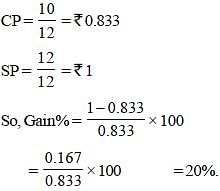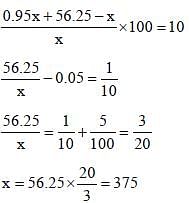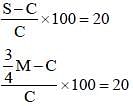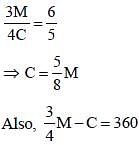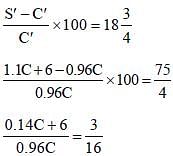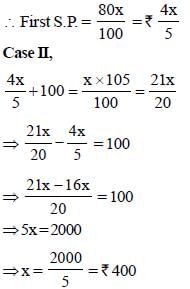SSC CGL Previous Year Questions: Profit & Loss - 3 - SSC CGL MCQ
30 Questions MCQ Test SSC CGL Mathematics Previous Year Paper (Topic-wise) - SSC CGL Previous Year Questions: Profit & Loss - 3
A man purchased an article for ₹ 1500 and sold it at 25% above the cost price. If he has to pay ₹ 75 as tax on it, his net profit percentage will be : (SSC CHSL 2nd Sit. 2015)
Successive discounts of 20% and 10% are equivalent to a single discount of : (SSC CHSL 2nd Sit. 2015)
| 1 Crore+ students have signed up on EduRev. Have you? Download the App |
A house was sold for ₹ y by giving a discount of x%, then the list price was : (SSC CHSL 1st Sit. 2015)
A fruit seller buys oranges at the rate of ₹ 10 per dozen and sells at the rate of ₹ 12 per dozen. His gain percent is : (SSC CHSL 1st Sit. 2015)
By selling an article for ₹450. I lose 20%. For what amount, should I sell it to gain 20%? (SSC CHSL 1st Sit. 2015)
A fruit seller buys 240 apples for ₹ 600. Some of these apples are bad and are thrown away. He sells the remaining apples at ₹ 3.50 each and makes a profit of ₹ 198. The % of apples thrown away are : (SSC Sub. Ins. 2015)
A man bought a watch at 25% discount on the original price. He got ₹40 more than the original price by selling it at 140% of the price at which he bought. The price of buying the watch was: (SSC Sub. Ins. 2015)
If a shopkeeper purchases cashewnut at ₹250 per kg and sells it at ₹ 10 per 50 grams, then he will have: (SSC Sub. Ins. 2015)
A trader marks his goods 20% above C.P. but allows his customers a discount of 10. The C.P. of a blackboard, which is sold for ₹ 216, is: (SSC Sub. Ins. 2015)
A sold an article to B at 20% profit and B sold it to C at 15% loss. If A sold it to C at the selling price of B, then A would make (SSC CGL 1st Sit. 2014)
Ram bought a T.V. with 20% discount on the labelled price. Had he bought it with 30% discount he would have saved ₹ 800. The value of the T.V. set that he bought is (SSC CGL 1st Sit. 2014)
A dealer of scientific instruments allows 20% discount on the marked price of the instruments and still makes a profit of 25%. If his gain over the sale of an instrument is ₹ 150, find the marked price of the instrument. (SSC CGL 1st Sit. 2014)
A shopkeeper allows 10% discount on goods when he sells without credit. Cost price of his goods is 80% of his selling price. If he sells his goods by cash, then his profit is (SSC CGL 1st Sit. 2014)
A man sold his watch at a loss of 5%. Had he sold it for ₹ 56.25 more, he would have gained 10%. What is the cost price of the watch (in ₹) ? (SSC CHSL 2014)
The marked price of an item is twice the cost price. For a gain of 15%, the discount should be (SSC CHSL 2014)
The marked price of a saree is ₹ 200. After allowing a discount of 20% on the marked price, the shopkeeper makes a profit of ₹ 16. Find the gain percent. (SSC CHSL 2014)
A retailer buys a sewing machine at a discount of 15% and sells it for ₹1955. Thus he makes a profit of 15%. The discount is (SSC Sub. Ins. 2014)
Mahesh earned a profit of 20% by selling 60 apples at the rate of ₹ 42.50 for 5 apples. Then the total cost, at which the apples were bought is (SSC Sub. Ins. 2014)
A tea-merchant professes to sell tea at cost price but uses a false weight of 900 gram for a kilogram. The profit percent in his transaction is (SSC Sub. Ins. 2014)
A shopkeeper sold an item for ₹ 1,800 at a discount of 10% and gained ₹ 200. Had he not given the discount, his gain would be (SSC Multitasking 2014)
Rita purchased a car with a marked price of ₹ 2,10,000 at a discount of 5%. If the sales tax charged is 10%, find the amount she has to pay. (SSC Multitasking 2014)
A cycle merchant allows 25% discount on the marked price of the cycles and still makes a profit of 20%. If he gains ₹ 360 over the sale of one cycle, find the marked price of the cycle. (SSC Multitasking 2014)
If a person lost 8% by selling an article for ₹ 1,035, he bought the article for (SSC Multitasking 2014)
Aman sells two watches at ₹ 99 each. On one he gets 10% profit and on the other he loses 10%. His net gain or loss percent is (SSC Multitasking 2014)
A bookseller sells a book at a profit of 10%. If he had bought it at 4% less and sold it for ₹ 6 more, he would have gained 18(3/4)%. The cost price of the book is (SSC Multitasking 2014)
The price of an article is first decreased by 20% and then increased by 30%. if the resulting price is ₹ 416, the original price of the article is. (SSC CGL 2nd Sit. 2013)
A tradesmen sold an article at a loss of 20%. if the selling price had been increased by ₹100. there would have been a gain of 5%. The cost price of the article (in ₹) was (SSC CGL 2nd Sit. 2013)
The list price of an article is ₹160 and a customer buys it for ₹122.40 after two successive discounts. If the first discount is 10%, then second discount is (SSC CGL 2nd Sit. 2013)
A shopkeeper earns a profit of 12% on selling a book at 10% discount on printed price. The ratio of the cost price to printed price of the book is (SSC CGL 2nd Sit. 2013)
A shopkeeper marks his goods 20% above his cost price and gives 15% discount on the marked price. His gain percent is (SSC CGL 2nd Sit. 2013)
|
21 docs|55 tests
|
|
21 docs|55 tests
|






